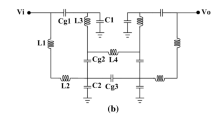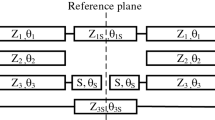Abstract
This paper presents a compact and novel dual-band bandpass filter (DBBPF) using a microstrip dual-mode resonator, folded stepped impedance resonator (SIR) and an etched ground structure (EGS). The first and second passbands are generated by the dual-mode and single-mode resonators. The proposed bandpass filter (BPF) produces passbands centered at 2.4 GHz and 3.5 GHz, respectively. The passband performance of the DBBPF is enhanced by etching a pattern in the ground plane which provides less than 1-dB insertion loss in both of the passbands with more than 20-dB isolation in the stopband. The BPF is analyzed using classical odd–even-mode technique. The simulated full-wave electromagnetic (EM) results obtained using IE3D are in well agreement with the theoretical results. The proposed DBBPF can be employed in WLAN and WiMAX applications.
Access provided by Autonomous University of Puebla. Download conference paper PDF
Similar content being viewed by others
Keywords
1 Introduction
Dual-band RF and microwave bandpass filters (DBBPFs) are subject of interest in recent days due to the growing demand for dual-band appliances. A DBBPF is an essential component in such systems. A conventional DBBPF can be designed by cascading two different bandpass filters (BPFs) having separate passbands, by embedding a different resonator into the primary resonator of the BPF and by the separation of various resonant modes generated by a multimode resonator. The first method is very straightforward and easy to implement, but such kind of DBBPF circuits is greater in size compared to others, and therefore, they are very rarely used nowadays. The second and third methods are prevalent for DBBPF designing. Some recent research articles related to different DBBPFs are shown in [1,2,3,4,5,6,7,8,9], which are implemented using [1] parallel-coupled stepped impedance resonators (SIRs), [2] microstrip line resonator loaded with an open-loop ring in one end which acts as an embedded resonator, [3] multimode E-shaped resonator, [4,5,6] dual-mode resonators, [7, 8] spiral resonators and [9] end-coupled resonators loaded with metallic via holes, respectively.
Although undoubtedly enormous research is already conducted on DBBPFs, further research is still required for the implementation of cost-effective and compact DBBPFs with good dual passband performance. In this paper, a novel and compact DBBPF is proposed using a dual-mode resonator, folded single-mode resonator and an etched ground structure (EGS). The dual-mode resonator generates the first passband near 2.4 GHz, and the folded microstrip line resonator produces the second passband near 3.5 GHz. The insertion loss in both of the passband is reduced by incorporating an EGS in the ground plane, which improves the cross-coupling between the resonators and feedline. All the resonators are analyzed using classical odd–even-mode technique. The proposed DBBPF is simulated in IE3D with RO4003C substrate (\( \varepsilon_{r} \) = 3.38, \( h \) = 0.508 mm, \( \tan \theta \) = 0.0018), which provides less than 1-dB insertion loss in both of the passbands and more than 20-dB rejection level up to twice the midband frequency.
2 Design and Analysis of the Proposed BPF
The proposed DBBPF is depicted in Fig. 1. All the labeled dimensions of the BPF are listed in Table 1. The BPF only consumes 18.75 × 9.55 mm2 core layout area. The coupling architecture of the DBBPF is illustrated in Fig. 2. The source and load are directly coupled to each other, whereas they are in cross-coupling mode with the dual-mode resonator (resonator 1) and folded SIR (resonator 2).
The proposed DBBPF is constructed using a fundamental dual-mode resonator of Fig. 3 and a microstrip line SIR of Fig. 4. Using classical transmission line and odd–even-mode techniques [10], the resonant frequencies of the dual-mode resonator in Fig. 3 are approximately calculated from its odd–even-mode equivalent circuits, which are shown in Eqs. (1) and (2), respectively.
[where ‘\( c \)’ is the velocity of light, ‘\( \varepsilon_{e} \)’ is the effective dielectric constant, and \( \left( {l_{1} + 2b_{1} + b} \right) \) and \( \left( {l_{1} + 2b_{1} + b + b_{2} } \right) \) are average lengths of the odd- and even-mode resonators.]
From Eqs. (1) and (2), the odd- and even-mode resonant characteristics are extracted by considering RO4003C microstrip transmission line, which are depicted in Fig. 4. It can be found that the resonant frequencies f1odd and f1even are closely spaced, and they can be separated by increasing the length of the dimension ‘b2.’
The second resonator of Fig. 1 is the folded version of a basic SIR shown in Fig. 5. The resonance frequency of the SIR is approximately calculated by using the transmission line techniques mentioned in [10], which is shown in Eq. (3). The tunability characteristic of the resonance frequency is depicted in Fig. 6, which indicates a monotonical decay of the resonance frequency as the average resonator length is increased.
3 Results and Discussion
The simulated scattering response of the proposed DBBPF (Fig. 1) in the presence and absence of EGS is depicted in Fig. 7. The initial dimensions of the DBBPF are extracted using Eqs. (1)–(3), and thereafter, some manual optimization is performed to get better results. At first, the resonant modes f1odd and f1even are set near to 2.4 GHz by adjusting the dimensions L1, L2, w2, a and the radius R of the dual-mode resonator of Fig. 1. The center frequency of the second passband is set near to 3.5 GHz by adjusting the dimensions L3, L4 and w4, respectively.
Figure 8 depicts the zoomed view of the DBBPF scattering response in the presence and absence of EGS. Although it can be found that the transmission zero locations are somewhat changed due to the inclusion of EGS in the ground plane, its effect in the passband can be more accurately observed in Fig. 8. The insertion loss in both of the passband is reduced near to 0.7 dB, which was around 1.2 dB for the previous case. The fractional bandwidth (FBW) in the passbands is 4.2% and 2%, respectively, which ensures achievement of high selectivity in both of the passbands.
This improvement in the passband performance can be explained by the current distribution patterns illustrated in Fig. 8. It can be found that the unused resonator in each of the frequency bands is properly deactivated due to the inclusion of EGS and therefore more power is transmitted in that specified passband. The folded SIR at 2.4 GHz is better deactivated in Fig. 9c compared to Fig. 9a. On the other hand at 3.5 GHz, the dual-mode resonator in Fig. 9d is better deactivated compared to Fig. 9b; thereby, more power transfer in each of the passband is obtained.
4 Conclusion
In this paper, a compact and novel DBBPF based on dual-mode resonator, folded SIR and EGS is proposed. The simulated DBBPF provides high selectivity in the both of the passbands with 20-dB outside-band isolation and less than 1-dB insertion loss in the operating frequencies (2.4, 3.5 GHz). The proposed BPF is suitable for WLAN (2.4 GHz) and WiMAX (3.5 GHz) applications.
References
Zhang, Y., Sun, M.: Dual-band microstrip bandpass filter using stepped-impedance resonators with new coupling schemes. IEEE Trans. Microwave Theory Tech. 54, 3779–3785 (2006)
Hsu, C.-Y., Chen, C.-Y., Chuang, H.-R.: A miniaturized dual-band bandpass filter using embedded resonators. IEEE Microwave Wirel. Compon. Lett. 21, 658–660 (2011)
Kuo, Y.-T., Chang, C.-Y.: Analytical design of two-mode dual-band filters using E-shaped resonators. IEEE Trans. Microwave Theory Tech. 60, 250–260 (2012)
Sun, S.: A dual-band bandpass filter using a single dual-mode ring resonator. IEEE Microwave Wirel. Compon. Lett. 21, 298–300 (2011)
Lerdwanittip, R., Namsang, A., Jantree, P.: Dual-band bandpass filter using stubs to controllable passband. Procedia Comput. Sci. 86, 11–14 (2016)
Xu, J., Zhu, C.-M.: Compact dual-band bandpass filter using uniform-impedance resonators and dual-mode resonator. Microwave Opt. Technol. Lett. 58, 1537–1540 (2016)
Xu, Z., Wei, B., Cao, B., Guo, X., Zhang, X., Heng, Y., Jiang, L., Zheng, T., Wang, J.: A compact dual-band bandpass superconducting filter using microstrip/CPW spiral resonators. IEEE Microwave Wirel. Compon. Lett. 23, 584–586 (2013)
Xiao, M., Sun, G., Xu, F.: Compact dual-band bandpass filters based on a novel defected ground spiral resonator. Microwave Opt. Technol. Lett. 57, 1636–1640 (2015)
Reja, A.H., Khader, A.A.-H., Ahmad, S.N., Salih, A.A.A.: Dual-band band-pass filters based on metallic via holes. Procedia Comput. Sci. 58, 748–754 (2015)
Hong, J.-S.: Microstrip filters for RF/microwave applications. Wiley, Hoboken, NJ (2011)
Acknowledgements
This work is supported by National Institute of Technology Agartala.
Author information
Authors and Affiliations
Corresponding author
Editor information
Editors and Affiliations
Rights and permissions
Copyright information
© 2019 Springer Nature Singapore Pte Ltd.
About this paper
Cite this paper
Sarkar, D., Moyra, T. (2019). A Compact and High Selective Microstrip Dual-Band Bandpass Filter. In: Pati, B., Panigrahi, C., Misra, S., Pujari, A., Bakshi, S. (eds) Progress in Advanced Computing and Intelligent Engineering. Advances in Intelligent Systems and Computing, vol 713. Springer, Singapore. https://doi.org/10.1007/978-981-13-1708-8_43
Download citation
DOI: https://doi.org/10.1007/978-981-13-1708-8_43
Published:
Publisher Name: Springer, Singapore
Print ISBN: 978-981-13-1707-1
Online ISBN: 978-981-13-1708-8
eBook Packages: EngineeringEngineering (R0)













